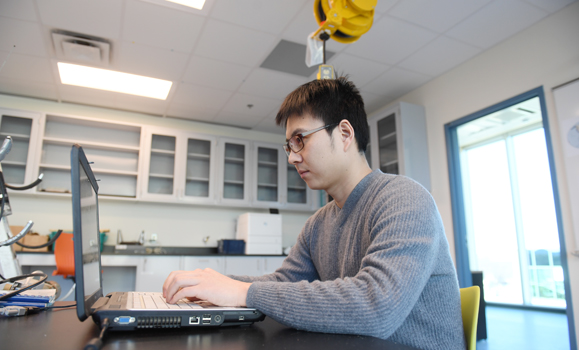A postdoctoral fellow studying at Dal as part of the is helping us better understand the Earth of 150 million years ago, when the supercontinent Pangaea broke up and the Atlantic Ocean was born ‚ÄĒ and he‚Äôs doing it by studying the rock off the coast of Nova Scotia.
Hanchao Jian is a marine geophysicist who, since arriving at Dalhousie in March 2018, is probing the crust and upper mantle off the Nova Scotian shore.
‚ÄúThe oldest rock formations of the Atlantic Ocean are here, and if we can understand their structure, we can determine what processes affected the creation of the Atlantic Ocean, and learn more about the history of the Earth,‚ÄĚ says Jian.
It all began when a crack formed in the then tropical region of Pangaea (the Bay of Fundy is a failed crack). Molten rock, extruded from below, contacted the newly-forming ocean and cooled into the beginnings of the seafloor.

Jian explains that the method used to determine the rock structure (seismic inversion), is analogous to an x-ray or CT scan. Researchers from a ship lower an instrument (a seismometer) to the seafloor to record seismic energy that is latter emitted by airgun shots and travels into the ocean crust and mantle. They then analyze the seismic signals to extract information about the Atlantic’s sub-seafloor.
Using the seismometer, Jian and his research colleagues can indirectly ‚Äúsee‚ÄĚ the composition of the oceanic crust and mantle, up to 40 km below the seafloor. ‚ÄúBy studying sub-seafloor processes, we understand why the seafloor looks like the shape we see.‚ÄĚ ¬†
The crack that began the Atlantic Ocean still exists as the Mid-Atlantic Ridge, a tens-of-kilometer wide tectonic plate boundary that runs predominantly north-south. There, the ocean basin, which has reached between about two and six km wide, one and six km deep, is still growing. Pliable rock comes up from the upper mantle, touches the ocean water, and cools and hardens quickly to form new seafloor.
In addition to conducting research at Dal, Jian’s work as part of the Ocean Frontier Institute’s (OFI) International Postdoctoral Fellowship program will include a 12-month stay at the Woods Hole Oceanographic Institute in Massachusetts.
At Dal, Jian is working with Earth Science Professor Mladen Nedimovińá and Assistant Professor of Oceanography David Barclay, and at Woods Hole, he will work with Associate Scientist of Geology and Geophysics, Juan Pablo Canales.
for the International Postdoctoral Program. Deadline is Feb. 28, 2019.

